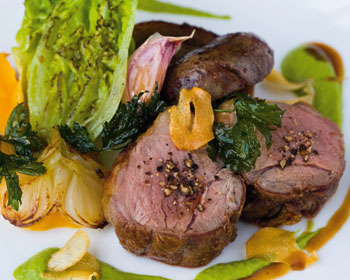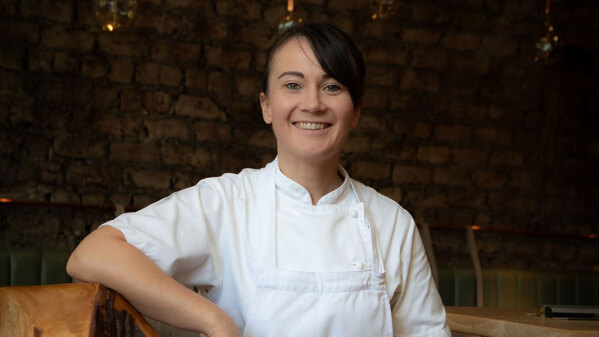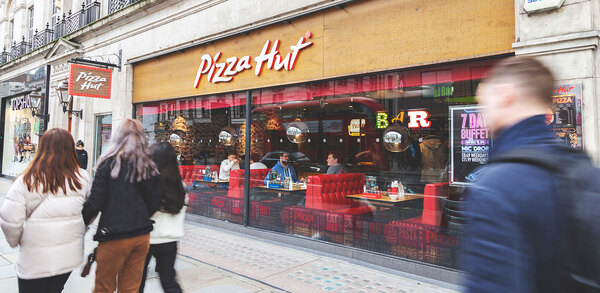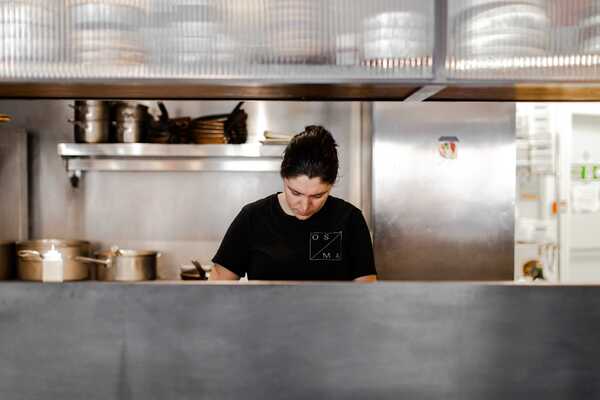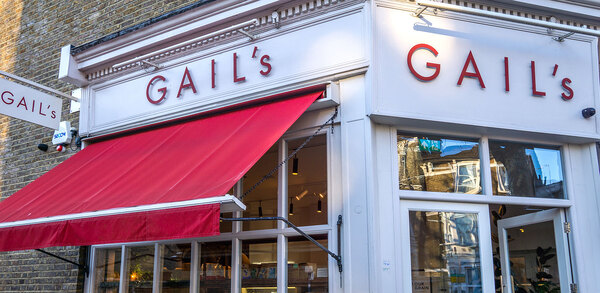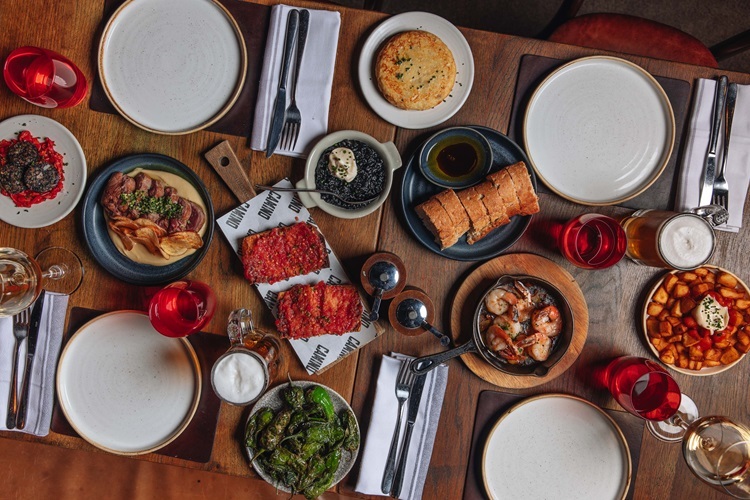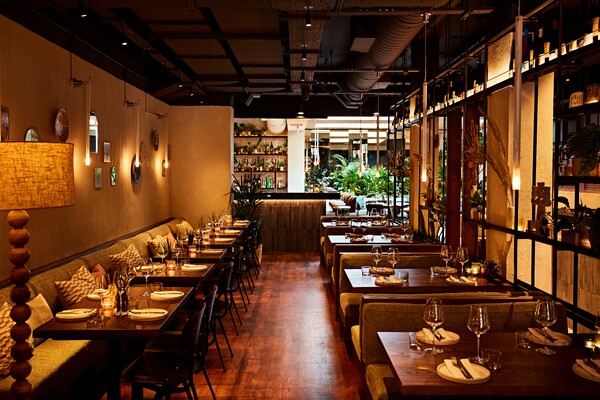Michelin-starred Tom Kitchin commits to Scottish produce
Tom Kitchin looks like being the biggest thing north of the border since Gordon Ramsay. He won a Michelin star six months after opening, and the Newcomer Award atey in July. Michael Raffael interviews a young man with a commitment to Scottish produce
Talking up the benefits of local seasonal produce isn't, by itself, original. So Tom Kitchin's emphasis on "From nature to plate" - on his menu, etched in a glass window of his Leith restaurant, and used as the title of a forthcoming cookery book - wouldn't convert some.
However, the structure of his business hinges on the chain of supply. The way he's geared up to buying scallops in their shells, whole fish, birds with their plumage untouched and primal cuts of meat on the bone shows that the young chef means business.
Kitchin opened his restaurant The Kitchin with his wife, Michaela, on a shoestring in 2006 in a high-risk location opposite the Scottish Executive headquarters, where three previous owners had failed. Five banks they approached for financial help turned them down. His pedigree, including five years with Pierre Koffmann and two with Alain Ducasse, left them cold. The sixth proved more sympathetic: "We found an older banker, who lived and breathed good food. He looked at my CV, at my wife, Michaela's, who had worked for the Savoy group and at Burj Al Arab, Dubai, and thought, ‘Bloody Hell!'"
But as to why they've succeeded where others haven't, Kitchin reckons he "arrived at the right time with a new approach, maybe interesting cuts of meat and unusual dishes. A husband-and-wife team that is very hands-on was something that people liked from the start."
"We've also spend a great amount of time in finding the right people," he says, "not just employing anyone with no interest in being here. We also have close communication between kitchen and the floor. The guys at the front know almost as much about the food and its preparation as the kitchen brigade, and all food is explained as it is being presented to the guests. The window to the kitchen shows that we're not hiding anything. Guests are invited to see what happens in a real kitchen - it can be blood and tears - plus kitchen banter moments."
Kitchin believes it's a myth that there is limited demand for Michelin-level food in Scotland. "Andrew Fairlie and Martin Wishart are full every day. What you have to watch is pricing. You can't start by having crazy levels for food from day one if you're not established."
Kitchin has plenty of regulars, but there are also weekend visitors from Edinburgh and London. "The American market is also quite large for us since some great reviews in Bon Appetit and the Wall Street Journal. We haven't spent a penny on advertising since we opened - for a small business it is hard to justify the costs - but have pushed quite heavily on PR."
However, he's not tempted to move back to London. "I had my time down south and loved it, but I have everything I want here in Scotland," he says. "There's fantastic produce, loyal customers and a busy restaurant, so I see no need to return. We live two minutes away from the restaurant and have a seven-months-old son now. I'm convinced I can reach all my goals on all sorts of levels here."
In the restaurant's first year Kitchin won a Michelin star. Pierre Koffmann had supplied the restaurant with crockery and cutlery held in store after his retirement. Michaela designed the restaurant interior and took charge of PR and personnel. Tom's father, a businessman, gave advice on costing and cash-flow. Money they saved on linen - they still have mats looking like chain mail instead of tablecloths - they spent on good-quality crystal glasses. "We tried to design it to be a restaurant that, as a couple, we would like to go ourselves," he says.
Kitchin's cooking is rooted in the French tradition. It's technique- rather than technology-based, because that's what he's learnt and what he's mastered. He isn't an innovator in the Blumenthal, Atherton or Campbell mould. Rather, he applies the skills he acquired working for the likes of Ducasse and Guy Savoy.
It's an approach with a strong provincial bias. At the Louis XV in Monte Carlo, where Kitchin spent two years, Ducasse turned out a refined vision of Provençal food. Koffmann's specialities were inspired by his Gascon origins. Cuisine Lyonnaise relies on a limited palette of ingredients and processes: Bresse chickens, pike, frogs' legs and charcuterie.
The restaurant revolution of the 1970s arrived late to Scotland, and its impact even now is patchy, but the country is slowly developing a gastronomic identity. The choice Perthshire lamb on The Kitchin's summer menu comes on the market at a time when English spring lamb is tailing off. Blairgowrie raspberries ripen in late August. Edinburgh chefs can buy locally foraged girolles when London has to depend on imports. Grouse, woodcock, mallard and partridge are abundant, but only available for a third of the year. The freshest fish and shellfish in the British Isles come from Scottish waters.
Tapping into these resources should be a no-brainer for the Scots, but it isn't always the case. According to Kitchin, a gulf still separates restaurants like his from the rank and file around the country. "They don't know how to recognise freshness don't know how to use bones to make sauces, how to use trimmings so nothing gets wasted," he says. "Of course, you've got your Andrew Fairlie and Martin Wishart, who are leaders of Scottish cookery, but there's a gap in the middle-of-the-range restaurant market as regards the use of local produce."
Knowing that there should be a distinct identity for Scottish cooking, something more than porridge, smoked salmon, haggis and fried Mars bars, is one thing. Giving it a reality that doesn't seem phoney is another. Kitchin's menu descriptions focus on the central ingredient of each dish: "langoustines from Anstruther", "lobster from Newhaven", "roast duck from Loomswood Farm", "hand-dived Orkney scallops".
This emphasis, he says, traces a logical pathway back to delivery at the kitchen door. "I buy all my fish whole, all the game whole, all the meat whole," he says. "The vegetables are delivered fresh every day."
Campbells Prime Meat supplies Scottish beef, lamb and pork. The Orkney scallops and the langoustines from Anstruther come from Ronnie at George Campbell, while Charlie Magee organises oysters, clams and razor shells. Ben Robertson, of Fungi & Forage, covers the wild mushrooms and herbs. Kilmarnock catering supplier Braehead Foods delivers game. Grouse come direct from shoots.
How he prepares individual dishes echoes the lessons of his mentors. The boned and rolled pig's head with crispy ears evolved from a Koffmann speciality. He is also, he says, striving to reinvent classics in a modern way. This involves giving back responsibility to the front-of-house staff. "It's not right for me to have big silver trolleys in our type of restaurant," he says, "but we use guéridon service to carve a rib of beef or a whole monkfish tail wrapped in pancetta at the customer's table."
It gives the chef freedom to cook dishes that don't depend on sautéing to order. "We're roasting a whole John Dory for three, with loads of basting, giving it lots of flavour, and we're taking it to the table and filleting - and why not?"
This is possible because Philippe Nublat, his maître d', also has a Ducasse stamp on his passport, as have other waiters. At the outset, Tom and Michaela had a team of seven including themselves. That number has grown to 23. The original wine list had 35 bins. That number has increased to 180.
Improvements have included doubling the kitchen space. Before the Michelin star he might have served 10 covers at lunch. Now it's about 40. For dinner, he begins service at 6.45pm and is re-laying tables by the end of the evening.
The chefs he employs learn craft skills without cutting corners. Some, he claims, have never seen a scallop in its shell or filleted a fish or made a stock. He expects these raw recruits to train with him for 18 months or two years, then he'll encourage them to move on and extend their knowledge. "Once they have their basics they should use them to travel, to gain experience, see the world," he believes. "Those who stay in the same country all their lives as chefs never have the same quality as those who have worked abroad."
Kitchin says that the most important personal lesson he has learnt is that a restaurant is like a jigsaw puzzle, where every position is key to the whole. However, a string of awards has ensured that he hasn't been able to escape the limelight. Apart from the Catey Newcomer Award this year, he was Scottish Chef of the Year in 2007 and has just won the AA's 2008 Restaurant of the Year title.
Selected to represent Scotland in the final of BBC's Great British Menu, Kitchin didn't win but enjoyed the interaction and banter with other chefs. The competition theme was "Modern British" and he felt that his style owed more to its French origins - not that he intended copying Jason Atherton's approach (Atherton won two of the categories). "We don't all have to be cooking the same way," he says. "I loved Jason's food, and he really liked mine. We got on well, but we don't do the same things."
The publicity brought a welter of would-be reservations to a restaurant that was already fully booked. It gave him a taste of how the celebrity game plays out - he'd do it again if asked.
Success at the relatively tender age of 30 has barely given him the chance to catch his breath, but he's looking to the future. A second Edinburgh restaurant is a possibility, but if it happens he won't stop cooking. He argues that customers should expect a chef to be behind the stoves at a restaurant identified with his name.
In fact, Kitchin maintains a balanced stance halfway between David Everitt-Matthias, who never misses a service, and Gordon Ramsay, the entrepreneur. "You always have to be developing," he insists. "That was drummed into me very early on by Koffmann. If you let things go, you're in trouble. You should set yourself a goal - when you reach it, you make the next one."
Kitchin's aim now is for two Michelin stars. "Two from the Red Guide is an ambition," he says. "But, I'm not going to change my style of cooking to try and win them."
Rump of lamb served with baby gem lettuce
Ingredients
(Serves four)
For the lettuce sauce (about 12 portions)
4 Baby Gem lettuces, roughly chopped
4 litres salted boiling water
1 onion, thinly sliced
10ml oil
Salt
140ml chicken stock
140ml double cream
For the lamb
4 lamb rumps
Oil
Salt and pepper
2 Baby Gem lettuces, halved
2 lambs' kidneys, halved
4 slices lamb belly confit (see below)
Method
To make the lettuce sauce, blanch the chopped Baby Gem in the boiling water for 30 seconds. Drain and refresh in an ice bath for two minutes. Squeeze out excess moisture and refrigerate.
In the meantime, slowly sweat the onion in a heavy-bottomed pot with oil and salt. Once the onion is soft, with no colour, add the chicken stock and cream. Reduce by almost two-fifths and transfer to a blender. Add chilled lettuce and blitz for five minutes or until smooth. Set aside.
Season each rump with salt and pepper and brown on all sides in a hot pan. Finish in a 200°C hot oven for roughly 8-10 minutes for a medium-rare. Make sure to let it rest at least 10 minutes so its juices are distributed evenly.
Remove any outer and damaged leaves from the halved Baby Gems. While the lamb is resting, season the lettuce, sear it, cut side-down, until golden brown. Sear and season the lambs' kidneys. Fry the slices of lamb belly about four minutes each side till crisp.
For each serving, warm lettuce sauce through and spoon on to plate. Top with the rested, sliced rump. Garnish the plate with your golden brown Baby Gem lettuce, crisp lamb belly and roast kidney.
Lamb belly confit
Ingredients
1 lamb belly
1tbs cumin
1tbs fennel seeds
Salt and pepper
Olive oil
Method
Season lamb all over with cumin, fennel seeds and salt and pepper. Place in a cooking tray and cover with olive oil. In a slow oven, cook gently until very tender (4-5 hours).
Carefully, while still warm, remove belly and roll into a log shape. Wrap tightly in clingfilm and let set in fridge until solid. Cut 12mm slices to order.
The people who matter
- David Lowrie Fish Merchants On the Firth of Forth, supplies the top-flight Edinburgh and Glasgow restaurants (2d Netherton Industrial Estate, Anstruther KY10 2DW. Tel: 07860 686042)
- George Campbell and Sons The Leith-based fishmonger and purveyor was founded in 1872 and is still going strong. It brings down the live Orkney scallops and creel-caught langoustines overnight. (35-37 Ferry Road, Edinburgh EH6 4AF. Tel: 0131-555 2433. Contact: Ronnie)
- Ben Robertson - Fungi & Forage Scotland has some of the best and most abundant wild mushrooms. Chanterelles and girolles thrive in the warm, damp late summer and autumn weather. (Tel: 07760 388378)
- Campbells Prime Meat Wholesale butcher specialising in Scottish beef and lamb (Brocks Way, Broxburn, Edinburgh EH52 5NB. Tel: 01506 858585. Contact: Peter Flockhart)
- Mark Murphy and Partner Fruit and vegetables (2 Newbridge Industrial Estate, Edinburgh EH28 8PJT. Tel: 0131-335 3040)
- Braehead Foods Fast-expanding game purveyor with its own processing plant (7 Moorfields North Industrial Park, Kilmarnock KA2 0EF. Tel: 01563 550008. Contact: Craig Stevenson)
- Charlie Magee A prized shellfish source for top Scottish restaurants (Tel: 07768 975445)



